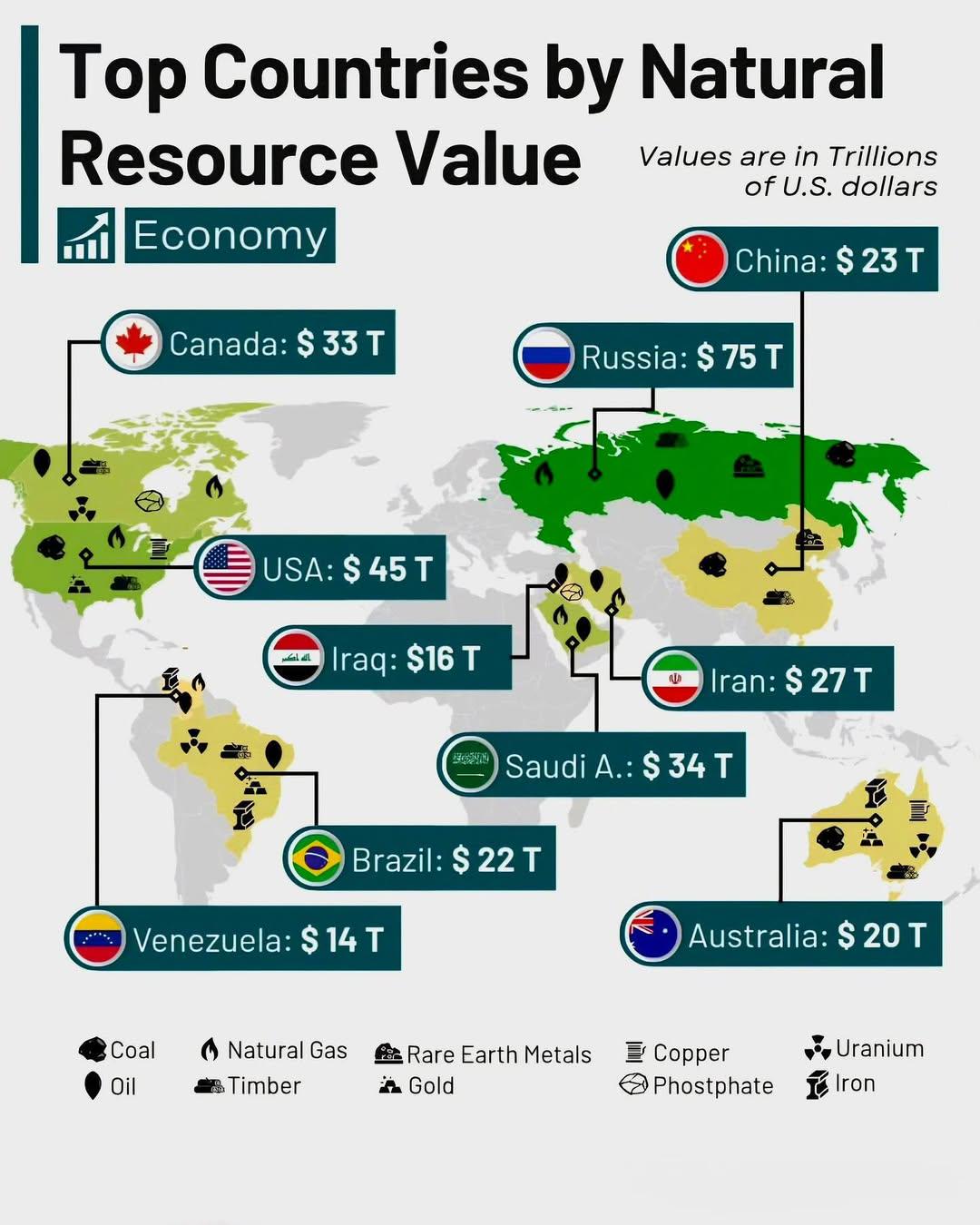Top Countries by Natural Resources Value Map


David Chen
Data Visualization Specialist
David Chen is an expert in transforming complex geographic datasets into compelling visual narratives. He combines his background in computer science ...
Geographic Analysis
What This Map Shows
The "Top Countries by Natural Resources Value Map" provides a comprehensive overview of the global distribution of natural resources, highlighting which nations possess the most valuable assets in terms of minerals, fossil fuels, and other natural commodities. This visualization is a powerful tool for understanding the economic foundations of various countries and how their resource wealth can influence global markets and geopolitics.
Natural resources, as defined here, encompass not just the obvious oil and gas reserves, but also valuable minerals like gold, copper, and rare earth elements that are increasingly important in our high-tech world. The map visually ranks countries by the estimated value of their natural resources, offering a clear glimpse into the economic potential tied to these assets.
Deep Dive into Natural Resources
Natural resources are the backbone of many economies around the world. They can be categorized into renewable resources, such as timber and fish, and non-renewable resources, like fossil fuels and minerals. The significance of these resources can't be overstated; they not only provide energy and raw materials but also shape the development trajectories of nations.
Take, for instance, the staggering value of oil reserves concentrated in the Middle East. Countries like Saudi Arabia, Iraq, and the United Arab Emirates lead the world in oil wealth, which plays a crucial role in their economic stability and political influence. Interestingly, in 2022, Saudi Arabia was estimated to hold around 266 billion barrels of proven oil reserves, giving it a significant upper hand in global energy markets.
On the flip side, countries rich in minerals, such as Australia and South Africa, also showcase how these resources can dictate a nation's economic landscape. Australia, for example, is a leading producer of iron ore and coal, which are vital for global infrastructure development. The value of these minerals can skyrocket based on global demand, affecting both the Australian economy and international trade dynamics.
Moreover, there are emerging players in the resource sector, such as Brazil, which is rich in iron ore and possesses large agricultural sectors that contribute to its resource wealth. The increasing demand for soybeans and other agricultural products from Brazil has made it a significant player in global food markets.
Interestingly, the rise of technology has also brought attention to rare earth elements, which are crucial for modern electronics and renewable energy technologies. Countries like China dominate the production of these elements, controlling about 60% of the world’s supply, which gives them considerable leverage in global tech industries.
Regional Analysis
When examining the map by region, it becomes evident that resource distribution is not uniform. In North America, the United States stands out with its vast reserves of coal, natural gas, and oil, while Canada is known for its rich deposits of minerals like gold, nickel, and potash. These resources contribute significantly to the economies of both nations, though environmental concerns are increasingly influencing policy and extraction methods.
In contrast, Europe has a diverse mix of resources, albeit on a smaller scale. Countries like Norway lead in oil production, while others, such as Germany, are known for their mineral wealth. However, Europe faces challenges in resource management, particularly with renewable energy transitions and sustainability.
Africa presents another intriguing case. Nations like the Democratic Republic of the Congo are rich in cobalt—an essential component for batteries—while South Africa is known for its platinum group metals. However, the extraction of these resources often comes with socio-economic challenges and political instability, raising questions about the equitable distribution of wealth.
Significance and Impact
Understanding the value of natural resources is crucial for grasping the broader economic and political landscape of our world. Resources can drive growth, but they can also lead to conflict and environmental degradation. For instance, the so-called 'resource curse' often afflicts countries that are heavily dependent on resource extraction, leading to corruption and neglect of other economic sectors.
Moreover, as the world shifts toward renewable energy, the importance of certain resources will change. Countries with abundant reserves of lithium, for example, are likely to become increasingly influential in the coming decades as electric vehicles and energy storage solutions become more mainstream.
As we look to the future, the interplay between natural resources, technology, and sustainability will be a focal point for nations worldwide. How countries manage their resource wealth will not only impact their own economies but will also shape international relations and global trade patterns. Keeping an eye on these dynamics will be essential for anyone interested in the future of our planet and its economies.
Visualization Details
- Published
- August 19, 2025
- Views
- 180
Comments
Loading comments...